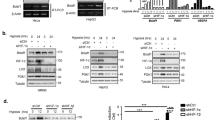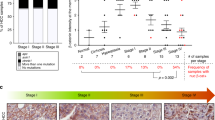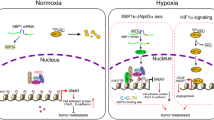Abstract
Aberrant activation of β-catenin promotes cell proliferation1 and initiates colorectal tumorigenesis2,3. However, the expansion of tumours and the inadequacy of their local vasculature results in areas of hypoxia where cell growth is typically constrained4,5. Here, we report a novel diversion in β-catenin signalling triggered by hypoxia. We show that hypoxia inhibits β-catenin–T-cell factor-4 (TCF-4) complex formation and transcriptional activity, resulting in a G1 arrest that involves the c-Myc–p21 axis. Additionally, we find that hypoxia inducible factor-1α (HIF-1α) competes with TCF-4 for direct binding to β-catenin. DNA–protein interaction studies reveal that β-catenin–HIF-1α interaction occurs at the promoter region of HIF-1 target genes. Furthermore, rigorous analyses indicate that β-catenin can enhance HIF-1-mediated transcription, thereby promoting cell survival and adaptation to hypoxia. These findings demonstrate a dynamic role for β-catenin in colorectal tumorigenesis, where a functional switch is instigated to meet the ever-changing needs of the tumour. This study highlights the importance of the microenvironment in transcriptional regulation.
This is a preview of subscription content, access via your institution
Access options
Subscribe to this journal
Receive 12 print issues and online access
$209.00 per year
only $17.42 per issue
Buy this article
- Purchase on Springer Link
- Instant access to full article PDF
Prices may be subject to local taxes which are calculated during checkout





Similar content being viewed by others
References
van de Wetering, M. et al. The β-catenin/TCF-4 complex imposes a crypt progenitor phenotype on colorectal cancer cells. Cell 111, 241–250 (2002).
Korinek, V. et al. Constitutive transcriptional activation by a β-catenin–Tcf complex in APC−/− colon carcinoma. Science 275, 1784–1787 (1997).
Morin, P. J. et al. Activation of β-catenin–Tcf signaling in colon cancer by mutations in β-catenin or APC. Science 275, 1787–1790 (1997).
Carmeliet, P. et al. Role of HIF-1α in hypoxia-mediated apoptosis, cell proliferation and tumour angiogenesis. Nature 394, 485–490 (1998).
Harris, A. L. Hypoxia — a key regulatory factor in tumour growth. Nature Rev. Cancer 2, 38–47 (2002).
Reya, T. & Clevers, H. Wnt signalling in stem cells and cancer. Nature 434, 843–850 (2005).
van de Wetering, M. et al. Armadillo coactivates transcription driven by the product of the Drosophila segment polarity gene dTCF. Cell 88, 789–799 (1997).
He, T. C. et al. Identification of c-MYC as a target of the APC pathway. Science 281, 1509–1512 (1998).
Hockel, M. & Vaupel, P. Tumor hypoxia: definitions and current clinical, biologic, and molecular aspects. J. Natl Cancer Inst. 93, 266–276 (2001).
Maxwell, P. H. et al. Hypoxia-inducible factor-1 modulates gene expression in solid tumors and influences both angiogenesis and tumor growth. Proc. Natl Acad. Sci. USA 94, 8104–8109 (1997).
Wang, G. L., Jiang, B. H., Rue, E. A. & Semenza, G. L. Hypoxia-inducible factor-1 is a basic-Helix-Loop-Helix-PAS heterodimer regulated by cellular O2 Tension. Proc. Natl Acad. Sci. USA 92, 5510–5514 (1995).
Semenza, G. L. Targeting HIF-1 for cancer therapy. Nature Rev. Cancer 3, 721–732 (2003).
Lal, A. et al. Transcriptional response to hypoxia in human tumors. J. Natl Cancer Inst. 93, 1337–1343 (2001).
Rosin-Arbesfeld, R., Cliffe, A., Brabletz, T. & Bienz, M. Nuclear export of the APC tumour suppressor controls β-catenin function in transcription. EMBO J. 22, 1101–1113 (2003).
Jaakkola, P. et al. Targeting of HIF-α to the von Hippel-Lindau ubiquitylation complex by O2-regulated prolyl hydroxylation. Science 292, 468–472 (2001).
Mosimann, C., Hausmann, G. & Basler, K. Parafibromin/Hyrax activates Wnt/Wg target gene transcription by direct association with β-catenin/Armadillo. Cell 125, 327–341 (2006).
Kaidi, A., Qualtrough, D., Williams, A. C. & Paraskeva, C. Direct transcriptional up-regulation of cyclooxygenase-2 by hypoxia-inducible factor (HIF)-1 promotes colorectal tumor cell survival and enhances HIF-1 transcriptional activity during hypoxia. Cancer Res. 66, 6683–6691 (2006).
van de Wetering, M. et al. Specific inhibition of gene expression using a stably integrated, inducible small-interfering-RNA vector. EMBO Rep. 4, 609–615 (2003).
Zhong, H. et al. Overexpression of hypoxia-inducible factor 1 α in common human cancers and their metastases. Cancer Res. 59, 5830–5835 (1999).
Vaupel, P., Thews, O., Kelleher, D. K. & Hoeckel, M. Current status of knowledge and critical issues in tumor oxygenation. Results from 25 years research in tumor pathophysiology. Adv. Exp. Med. Biol. 454, 591–602 (1998).
Goethals, L. et al. Hypoxia in human colorectal adenocarcinoma: comparison between extrinsic and potential intrinsic hypoxia markers. Int. J Radiat. Oncol. Biol. Phys. 65, 246–254 (2006).
Goda, N. et al. Hypoxia-inducible factor 1α is essential for cell cycle arrest during hypoxia. Mol. Cell Biol. 23, 359–369 (2003).
Kim, J. H. et al. Transcriptional regulation of a metastasis suppressor gene by Tip60 and β-catenin complexes. Nature 434, 921–926 (2005).
Essers, M. A. et al. Functional interaction between β-catenin and FOXO in oxidative stress signaling. Science 308, 1181–1184 (2005).
Giles, R. H. et al. Interplay between VHL/HIF1α and Wnt/β-catenin pathways during colorectal tumorigenesis. Oncogene 25, 3065–3070 (2006).
Iyer, N. V. et al. Cellular and developmental control of O2 homeostasis by hypoxia-inducible factor 1 α. Genes Dev 12, 149–162 (1998).
Maretto, S. et al. Mapping Wnt/β-catenin signaling during mouse development and in colorectal tumors. Proc. Natl Acad. Sci. USA 100, 3299–3304 (2003).
Chell, S. D. et al. Increased EP4 receptor expression in colorectal cancer progression promotes cell growth and anchorage independence. Cancer Res. 66, 3106–3113 (2006).
Elder, D. J., Hague, A., Hicks, D. J. & Paraskeva, C. Differential growth inhibition by the aspirin metabolite salicylate in human colorectal tumor cell lines: enhanced apoptosis in carcinoma and in vitro-transformed adenoma relative to adenoma relative to adenoma cell lines. Cancer Res. 56, 2273–2276 (1996).
Essafi, A. et al. Direct transcriptional regulation of Bim by FoxO3a mediates STI571-induced apoptosis in Bcr-Abl-expressing cells. Oncogene 24, 2317–2329 (2005).
Acknowledgements
We would like to thank: P. Ratcliffe and C. Pugh for providing HIF-1α expression constructs, B. Vogelstein for providing β-catenin expression vectors, K. Basler and C. Mosimann for the β-catenin truncations, E. Fearon for the TCF-4DN expression vector, K. Malik for technical advice, K. Brown and B. Hassan for the critical reading of the manuscript. This work was funded by a scholarship from the Algerian Government, the Citrina foundation, and a programme grant from Cancer Research UK.
Author information
Authors and Affiliations
Corresponding author
Ethics declarations
Competing interests
The authors declare no competing financial interests.
Supplementary information
Supplementary Information
Supplementary Figures S1, S2 and S3 (PDF 382 kb)
Rights and permissions
About this article
Cite this article
Kaidi, A., Williams, A. & Paraskeva, C. Interaction between β-catenin and HIF-1 promotes cellular adaptation to hypoxia. Nat Cell Biol 9, 210–217 (2007). https://doi.org/10.1038/ncb1534
Received:
Accepted:
Published:
Issue Date:
DOI: https://doi.org/10.1038/ncb1534
This article is cited by
-
Ischemia-reperfusion injury: molecular mechanisms and therapeutic targets
Signal Transduction and Targeted Therapy (2024)
-
Functional Roles of CD133: More than Stemness Associated Factor Regulated by the Microenvironment
Stem Cell Reviews and Reports (2024)
-
β-catenin-IRP2-primed iron availability to mitochondrial metabolism is druggable for active β-catenin-mediated cancer
Journal of Translational Medicine (2023)
-
Wnt7a Decreases Brain Endothelial Barrier Function Via β-Catenin Activation
Molecular Neurobiology (2023)
-
Warburg effect in colorectal cancer: the emerging roles in tumor microenvironment and therapeutic implications
Journal of Hematology & Oncology (2022)



